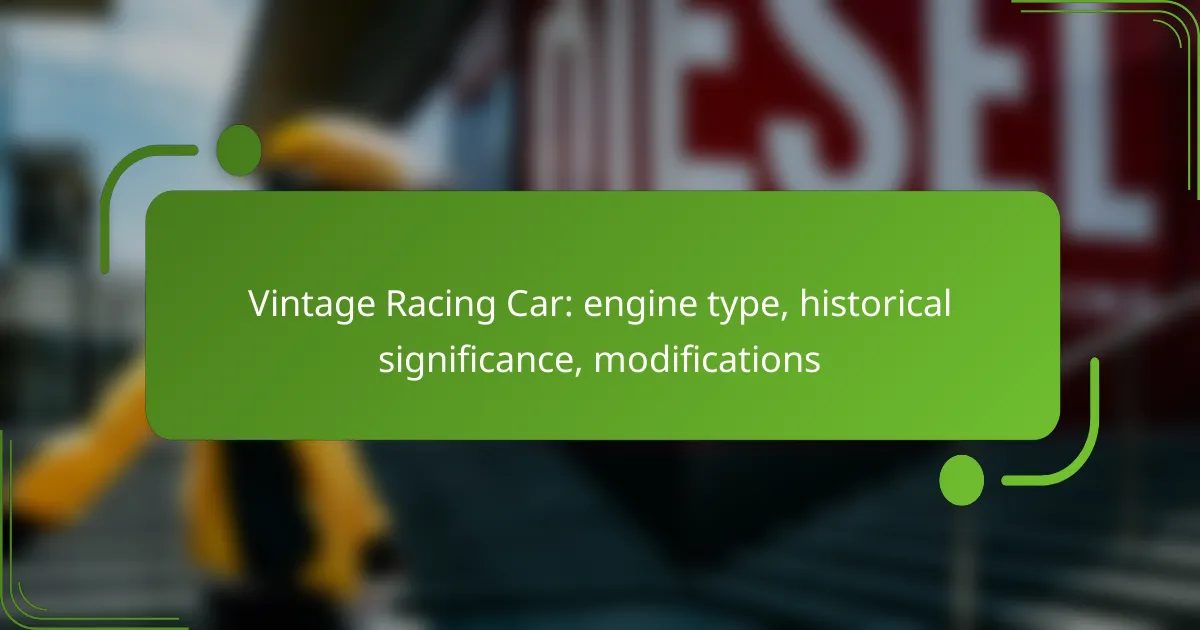Vintage racing cars, featuring engine types like V8, inline-four, flat-six, and V12, are celebrated for their unique performance characteristics and historical significance. As technology has advanced, these vehicles have evolved from basic machines into sophisticated racing tools, showcasing innovations in aerodynamics and safety. In Canada, vintage racing cars represent a vital part of automotive history, highlighting the cultural impact of motorsport and the dedication of enthusiasts who preserve this heritage.

What are the best vintage racing car engine types?
The best vintage racing car engine types include V8, inline-four, flat-six, and V12 engines, each offering unique characteristics that affect performance, sound, and historical significance. Choosing the right engine type depends on the specific racing context, desired power output, and personal preference.
V8 engines
V8 engines are renowned for their power and torque, making them a popular choice in vintage racing. Typically featuring eight cylinders arranged in a V configuration, these engines can produce significant horsepower, often exceeding 300 hp in classic models. Their deep rumble and robust performance have made them iconic in motorsport history.
When considering a V8 for vintage racing, be aware of the weight-to-power ratio, as these engines can be heavier than others. Ensure proper tuning and maintenance to maximize performance on the track.
Inline-four engines
Inline-four engines are lighter and more compact, making them ideal for smaller vintage racing cars. With four cylinders arranged in a straight line, they often provide a balance of efficiency and adequate power, typically ranging from 100 to 200 hp. Their simplicity and ease of tuning make them a favorite among enthusiasts.
While inline-four engines may not deliver the raw power of larger configurations, they excel in handling and agility, which can be advantageous on twisty circuits. Consider modifications that enhance airflow and reduce weight for improved performance.
Flat-six engines
Flat-six engines, commonly associated with brands like Porsche, offer a unique design that lowers the center of gravity, enhancing stability. These engines typically produce between 150 and 300 hp, depending on the model and modifications. Their distinctive sound and smooth power delivery contribute to their allure in vintage racing.
When working with flat-six engines, focus on optimizing the intake and exhaust systems to unlock their full potential. Regular maintenance is crucial, as these engines can be sensitive to tuning changes.
V12 engines
V12 engines are celebrated for their smoothness and high-revving capabilities, often found in luxury and high-performance vintage racing cars. With twelve cylinders, they can produce impressive horsepower, often exceeding 400 hp in racing applications. Their complex design allows for a unique engine note that many enthusiasts cherish.
However, V12 engines can be more challenging to maintain and repair due to their complexity. Ensure you have access to specialized knowledge and parts when considering a V12 for vintage racing.
Comparison of engine types
When comparing vintage racing car engine types, consider factors such as power output, weight, and handling characteristics. V8 engines provide brute force, while inline-fours offer agility and efficiency. Flat-sixes strike a balance between the two, and V12 engines deliver unparalleled smoothness and power.
Ultimately, the choice of engine type should align with your racing goals and the specific characteristics of the car. Evaluate the racing environment, whether it’s a track with tight corners or long straights, to determine which engine will give you the best performance advantage.

How has vintage racing car technology evolved?
Vintage racing car technology has evolved significantly over the decades, focusing on enhancing performance, safety, and reliability. Innovations in aerodynamics, materials, and safety features have transformed these vehicles from simple machines into highly engineered racing tools.
Advancements in aerodynamics
Aerodynamics plays a crucial role in the performance of vintage racing cars, influencing speed and stability. Early models relied on basic shapes, while modern designs incorporate wind tunnel testing to refine body contours, reducing drag and improving downforce.
For example, the introduction of spoilers and diffusers has allowed vintage cars to maintain better traction at high speeds. These modifications can lead to significant performance enhancements, making them competitive even in contemporary racing environments.
Improvements in materials
The materials used in vintage racing cars have evolved from heavy steel to lightweight composites and alloys. This shift not only reduces the overall weight of the vehicle but also enhances its strength and durability.
Common materials now include carbon fiber and aluminum, which offer superior performance characteristics. These advancements allow for faster lap times and improved handling, making vintage cars more appealing to collectors and racers alike.
Modern safety features
Safety features in vintage racing cars have seen considerable upgrades, reflecting the increased emphasis on driver protection. Modern enhancements include reinforced cockpits, advanced seat belts, and fire suppression systems, which were often absent in earlier models.
Implementing these safety measures can significantly reduce the risk of injury during races. Vintage racing organizations often encourage or require these upgrades to comply with contemporary safety standards, ensuring a safer racing environment for all participants.

What is the historical significance of vintage racing cars in Canada?
Vintage racing cars hold a prominent place in Canada’s automotive history, symbolizing the evolution of motorsport and its cultural impact. These vehicles not only showcase engineering advancements but also reflect the passion and dedication of Canadian enthusiasts who have preserved this rich heritage.
Influence on motorsport culture
Vintage racing cars have significantly shaped motorsport culture in Canada by inspiring a sense of nostalgia and community among enthusiasts. Events featuring these classic vehicles foster camaraderie and a shared appreciation for the craftsmanship and history behind each model.
The presence of vintage racing cars at events often encourages younger generations to engage with motorsport, ensuring the continuation of this vibrant culture. This influence is evident in the growing number of clubs and organizations dedicated to preserving and promoting vintage racing.
Key Canadian racing events
Several key events in Canada celebrate vintage racing, drawing participants and spectators from across the country. The Canadian Historic Grand Prix, held annually at the Circuit Mont-Tremblant, is one of the most notable, featuring a diverse range of classic racing cars.
Another significant event is the Vancouver Island Motorsport Circuit’s Vintage Race Weekend, which showcases vintage vehicles and provides a platform for enthusiasts to share their passion. These events not only highlight the historical significance of these cars but also contribute to the local economy through tourism and community engagement.
Notable Canadian vintage racing cars
Among the notable vintage racing cars in Canada, the 1964 McLaren M1A stands out for its engineering excellence and competitive history. This car represents the early days of Canadian motorsport and has been a favorite at vintage racing events.
Another significant model is the 1952 Jaguar C-Type, known for its performance and iconic design. These cars, along with others, are often showcased in exhibitions and races, reminding enthusiasts of the rich legacy of Canadian automotive history.

What modifications can enhance vintage racing car performance?
Modifications that enhance vintage racing car performance typically focus on improving engine efficiency, suspension handling, and reducing overall weight. These changes can lead to better speed, handling, and overall race competitiveness.
Engine tuning options
Engine tuning is crucial for maximizing the performance of vintage racing cars. Options include adjusting the carburetor for optimal air-fuel mixture, upgrading ignition systems, and fine-tuning the timing. These adjustments can significantly improve horsepower and torque, making the car more responsive on the track.
Consider using aftermarket performance parts such as high-performance camshafts or exhaust systems. These components can enhance airflow and combustion efficiency, resulting in better acceleration. However, ensure that any modifications comply with racing regulations to avoid disqualification.
Suspension upgrades
Upgrading the suspension system can greatly improve a vintage racing car’s handling and stability. Options include installing adjustable shock absorbers and performance springs, which allow for better control over weight transfer during cornering. This can lead to improved grip and faster lap times.
Additionally, consider reinforcing the chassis to reduce flex and enhance rigidity. This can provide a more stable platform during high-speed maneuvers. Always balance suspension upgrades with tire selection to ensure optimal performance on the track.
Weight reduction techniques
Reducing weight is a key strategy for enhancing performance in vintage racing cars. Common techniques include replacing heavy components with lightweight alternatives, such as using carbon fiber or aluminum parts. This can lead to improved acceleration and braking performance.
Another effective method is to strip unnecessary interior features and use lightweight racing seats. However, be mindful of safety regulations, as some modifications may impact structural integrity. Aim for a balanced approach to weight reduction to maintain handling characteristics while improving speed.

What are the criteria for selecting a vintage racing car?
When selecting a vintage racing car, key criteria include the vehicle’s condition, restoration history, and its racing pedigree. These factors significantly influence both the car’s performance and its historical value.
Condition and restoration history
The condition of a vintage racing car is paramount. Look for vehicles that have been well-preserved or restored using original parts to maintain authenticity. A thorough inspection should reveal the extent of any modifications and repairs, which can affect both performance and value.
Restoration history is equally important. Cars that have undergone extensive restoration may have lost some of their original character, while those with minimal work may retain more historical significance. Always verify the quality of the restoration and whether it aligns with industry standards.
Racing pedigree
A vintage racing car’s racing pedigree refers to its history in competitive events. Cars that have participated in notable races or have been driven by famous racers often command higher prices and greater interest among collectors. Provenance can significantly enhance a car’s appeal.
When assessing a car’s racing pedigree, consider its achievements, such as wins or podium finishes in prestigious events. Documentation, such as race records or photographs, can provide valuable insights into the car’s competitive history and authenticity.
